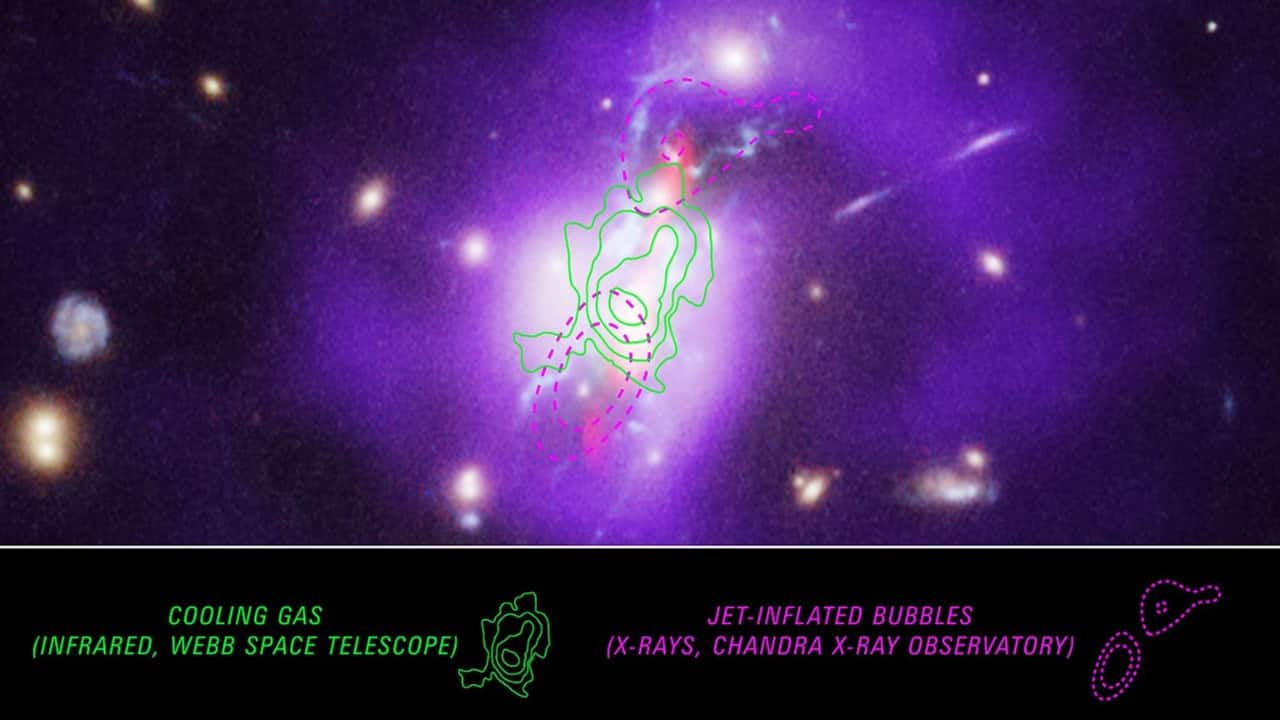



Researchers have solved the mystery of a galaxy cluster's rapid star formation. Using the James Webb Space Telescope, they studied the Phoenix cluster. This cluster, 5.8 billion light-years from Earth, has baffled scientists for years.
The Phoenix cluster has an extremely massive black hole at its centre. In other clusters, black holes prevent gas from cooling. Despite this, the Phoenix cluster is seeing intense star formation. Researchers were puzzled by the rate at which stars formed. They studied the cooling gas within the cluster to figure it out.
Michael McDonald from MIT compared the process to a ski slope. The cluster holds the largest reservoir of cooling gas. Yet, not all the gas cools enough to form stars. Webb’s findings showed where the missing gas was located.
 Spectroscopic data collected from NASA’s James Webb Space Telescope is overlayed on an image of the Phoenix cluster that combines data from NASA’s Hubble Space Telescope, Chandra X-ray Observatory and the Very Large Array (VLA) radio telescope. Webb’s powerful sensitivity in the mid-infrared detected the cooling gas that leads to a furious rate of star formation in this massive galaxy cluster. (Image: NASA)Webb Telescope Finds Key Cooling Gas
Spectroscopic data collected from NASA’s James Webb Space Telescope is overlayed on an image of the Phoenix cluster that combines data from NASA’s Hubble Space Telescope, Chandra X-ray Observatory and the Very Large Array (VLA) radio telescope. Webb’s powerful sensitivity in the mid-infrared detected the cooling gas that leads to a furious rate of star formation in this massive galaxy cluster. (Image: NASA)Webb Telescope Finds Key Cooling GasWebb detected the warm gas missing from earlier studies. This gas exists in cavities near the hot gas. The temperatures range from 18 million to 18,000 degrees Fahrenheit. The discovery fills in the missing pieces of the puzzle. Webb’s instruments allowed a deeper look at the cluster’s core.
McDonald explained that previous studies couldn’t detect the warm gas. With Webb, the team could study the gas for the first time. The Mid-Infrared Instrument (MIRI) helped capture this crucial data.
 This image of the Phoenix cluster combines data from NASA’s Hubble Space Telescope, Chandra X-ray Observatory, and the Very Large Array radio telescope. X-rays from Chandra depict extremely hot gas in purple. Optical light data from Hubble show galaxies in yellow, and filaments of cooler gas where stars are forming in light blue. Outburst generated jets, represented in red, are seen in radio waves by the VLA radio telescope. (Image: NASA)New Technique Could Change Galaxy Cluster Studies
This image of the Phoenix cluster combines data from NASA’s Hubble Space Telescope, Chandra X-ray Observatory, and the Very Large Array radio telescope. X-rays from Chandra depict extremely hot gas in purple. Optical light data from Hubble show galaxies in yellow, and filaments of cooler gas where stars are forming in light blue. Outburst generated jets, represented in red, are seen in radio waves by the VLA radio telescope. (Image: NASA)New Technique Could Change Galaxy Cluster StudiesThe discovery also relies on two ionized atoms, neon and oxygen. The emission from oxygen is brighter, but visible only in ultraviolet. Neon’s fainter glow is detectable in the infrared. Webb’s sensitivity to mid-infrared wavelengths helped detect this faint glow.
The team now hopes to apply this method to other galaxy clusters. While Phoenix is unique, this discovery is an important milestone. Webb continues to unlock the mysteries of galaxy formation and star birth.
Discover the latest Business News, Sensex, and Nifty updates. Obtain Personal Finance insights, tax queries, and expert opinions on Moneycontrol or download the Moneycontrol App to stay updated!
Find the best of Al News in one place, specially curated for you every weekend.
Stay on top of the latest tech trends and biggest startup news.